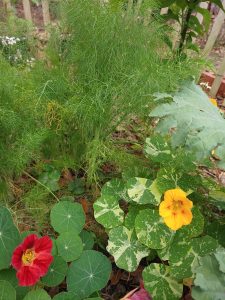Oberon: I know a bank where the wild thyme blows,
Where oxlips and the nodding violet grows,
Quite over-canopied with luscious woodbine,
With sweet musk-roses and with eglantine:
There sleeps Titania sometime of the night
[A Midsummer Night’s Dream, Act 2, Scene 1]
Aromatic plants add delight and wonder to any landscape. Whether brushing a rosemary twig gently as you pass by or being enticed by the delicate waft of jasmine, smell is one of the most poignant of our senses. Smell can draw us back to a particular memory, elicit emotions, and create vivid reactions. Incorporating aromatic plants into our gardens and green spaces has been practiced into antiquity. While the names of plants have changed over time, their meaning and our fascination with them has continued.

If you are interested in installing an aromatic garden or adding aromatic plants to your landscape, consider the following species and planting recommendations.
- Lavender (Lavandula spp.): Lavender is a perennial shrubby herb. Choose Spanish lavender or French lavender varieties that are better suited to the humidity. Lavender often prefers a constrained root environment, consider planting in shallow terra cotta containers or adding some gravel to the soil mix.
- Rosemary (Rosmarinus officinalis): Rosemary is a versatile perennial herb known for its aromatic foliage. It’s drought-tolerant and with proper pruning can form a low attractive hedge.
- Basil (Ocimum basilicum): Basil is an annual herb, it comes in many varieties, not only providing aroma but varieties like Thai basil or African Blue Basil are attractive to pollinators.
- Mint (Mentha spp.): Chocolate, pineapple, cinnamon, oh my! Mint comes in many varieties. This low growing perennial will spread rapidly in the ground. Consider planting in hanging planters or containers with other taller flowers.
- Lemongrass (Cymbopogon citratus): Lemongrass is a perennial clumping grass. It can reach heights of 4 feet or more, be sure to give your lemongrass plenty of room and harvest it when blades reach a diameter of approx.. ½ inch.
- Jasmine (Jasminum spp.): Fragrant jasmine plants, such as Confederate jasmine (Jasminum samac), produce beautiful, highly aromatic flowers. They thrive in the heat and can be trained to climb fences or trellises.
- Gardenia (Gardenia jasminoides): Gardenia plants are famous for their large, white, highly fragrant blooms. They love the heat and humidity of Florida but may need some protection during cold snaps.
- Plumeria (Plumeria spp.): Plumeria, also known as frangipani, is renowned for its sweet fragrance and attractive flowers. They are well-suited to Florida’s climate and can be grown in containers or in the ground.
- Fringetree (Chionanthus virginicus): A small aromatic tree, this native Florida plant can be a great addition to your landscape, blooming with white fringe-like flowers, this small tree or large shrub also attracts pollinators.
- Sweet Acacia (Vachellia farnesiana): This is also a small aromatic tree native to Florida, great for pollinators, the small globe shaped yellow flowers have a pleasant sweet smell. Be sure to plant out of a main thoroughfare due to it’s thorny nature.
When planning your aromatic garden in southwest Florida, make sure to provide well-drained soil, ample sunlight (between 6-8 hours), and appropriate watering to suit the specific needs of each plant. Clustering plants of similar needs is an important landscape maintenance practice recommended by the Florida-Friendly Landscaping TM program. If you are unsure about the needs of your specific plant, contact your local extension office.
 6
6
